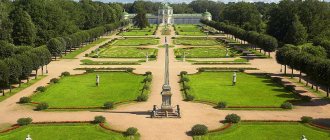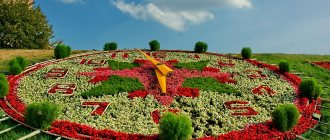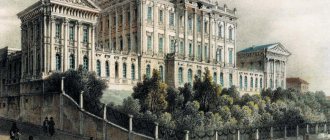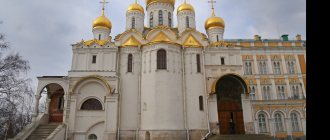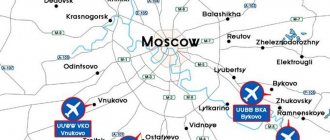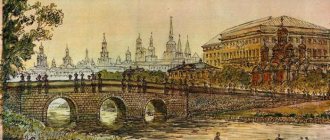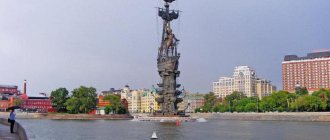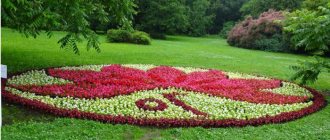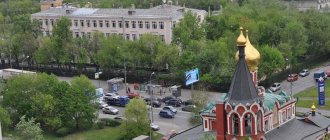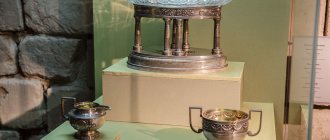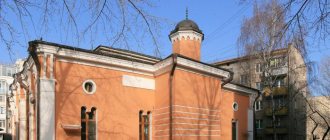20.12.1781, 16.05.1883, 23.11.1993, 01.02.1995, 11.06.2003
Number in the Heraldic Register of the Russian Federation:
196
State Register of the Russian Federation: No. 196
The coat of arms of the city of Moscow is an image on a dark red heraldic shield with a width to height ratio of 8:9, a horseman deployed to the right of the viewer - St. George the Victorious in silver armor and a blue mantle (cloak), on a silver horse, striking the black Serpent with a golden spear
.
The author of the sketch of the coat of arms of Moscow is the artist K. K. Ivanov. In general, the compositional design of the coat of arms of 1780 was preserved, but St. George acquired the traditional armor and pointed helmet for Russian warriors. Compared to the 1781 coat of arms, the colors of the armor and mantle of the rider, as well as the spear, were also refined. The color of the dragon, in contrast to the 1883 coat of arms, was left black (as in the 1780 coat of arms).
Approved
November 23, 1993, by order of the Mayor of Moscow No. 674-RM “On the restoration of the historical Coat of Arms of the City of Moscow”; re-approved by Moscow City Law No. 4-12 “On the coat of arms and flag of the city of Moscow” (approved on February 1, 1995 by Resolution No. 12 of the Moscow City Duma) and by Moscow City Law No. 39 “On the coat of arms of the city of Moscow” dated June 11, 2003.
Sketch of the coat of arms of Moscow 1991, artist K. K. Ivanov
In fact, the historical coat of arms was restored in 1991, when the artist K.K. Ivanov proposed his sketch (where the rider looked like a Greek), but the coat of arms was not approved then, although it was used unofficially. The coat of arms was officially restored only in 1993.
The heraldic image and description of the horseman - as St. George the Victorious - do not correspond to the norms of Orthodox iconography, in which saints are usually depicted with a halo. In addition, being turned to the viewer's right side, the image of the horseman on the modern official coat of arms of Moscow contradicts the rule of Western European heraldry, according to which living creatures on the coat of arms should be turned only to the viewer's left (right heraldic) side. This rule was established so that the figure depicted on the knight's shield, which was traditionally held at the left side, did not appear to be running away from the enemy. In the coat of arms of Moscow in 1883, the rider was turned to the viewer’s left (heraldic right) side, but in 1993, with the restoration of the historical coat of arms, the rider was again turned as in the coat of arms of 1780.
The dragon rider as a symbol of the Moscow principality has been known since at least the 16th century and was the central element of the coat of arms first of the Moscow kingdom and then of the Russian Empire. The image of a horseman is also present in the central part of the coat of arms of the Russian Federation, however, according to the official description of the coat of arms, this element is not described as St. George and is not mentioned as the coat of arms of the city of Moscow.
History of changes
Having appeared on the emblem of the Moscow Principality back in the 16th century, St. George the Victorious was absent from it only in Soviet times, from 1924 to 1993.
St. George the Victorious
His image on the coat of arms of Moscow over such a long period of time was significantly changed several times:
- In 1780, on the banner of the Moscow regiment, described in the “Znamenny coat of arms”, Saint George was depicted as in the modern version of the coat of arms, only on his head was a golden crown (crown), the cloak behind his back was yellow, the field at the feet of the serpent was white, the rest background – bright red. The direction of the rider is to the right of those looking at the heraldic shield. There is a cross on the warrior’s spear. It is worth noting that before the times of Peter the Great, the horseman depicted on the emblem of the Moscow princes was not identified as Saint George, but was correlated with the image of the ruling tsar.
- On Catherine’s coat of arms of Moscow in 1781, St. George the Victorious is depicted as on the regimental banner, only the background of the field is completely red, the crown is removed - the rider is dressed in knightly armor, the spear has lost the cross. The color scheme, as well as the movement of the horse towards the left side of the heraldic shield, remained unchanged.
- In 1883, during the reign of Alexander III, the coat of arms was changed in accordance with the heraldic canons, and Saint George began to look different: the rider was turned to the right side according to heraldic laws (left, if you look at the image on the shield), he struck the enemy with a spear, holding the shaft with both hands. A cross appeared on the spear again. The knight's armor was replaced by half-armor, which together with the helmet was yellow, and the cloak became blue. The horse lost its whiteness and changed its color to black. The serpent was replaced by a dragon
The coat of arms with the Great Martyr George was abolished after the revolution and the Soviet coat of arms of Moscow was used until the modern Moscow coat of arms.
Coats of arms of the Administrative Districts of Moscow on badges
1991 turned out to be a year of dramatic changes for the Soviet Union, which the country could not withstand, collapsing by December. New coins and banknotes appeared in wallets, but this brought joy to few people, since the population was shocked first by the financial losses during the “Pavlovsk” exchange, and then by the inflation of still regulated state prices. The lack of food in retail outlets was felt not only in the periphery, which had already become accustomed to life on coupons since about the mid-80s, but even in the capital. Long queues formed for food and essential goods.
Moscow. 1991
But in the same year, the capital carried out a reform of the administrative-territorial division, the results of which are still used to this day. According to the order of Moscow Mayor Gavriil Popov dated August 2, 1991, temporary boundaries of new territorial units - administrative districts - are established. Initially, each administrative district was assembled from smaller municipal districts. Currently they are divided into districts and settlements. Administrative districts acquired heraldic symbols much later than their formation: at the turn of the century. The coats of arms of the administrative districts of Moscow are represented by a series of ten badges.
Eastern District
Before the transformation of the map of the capital in connection with the annexation of new territories, the Eastern Administrative District was the largest territorially and ranked second in terms of population. The place where the district is located was used by the nobility of the Russian kingdom for hunting and outdoor entertainment. In this regard, the palace of Tsar Alexei Mikhailovich, an adherent of falconry, is being built on this territory. Everything changed radically under Peter I, who decided to conduct maneuvers of the Amusement Troops here, on the basis of which the sovereign later created the regular Russian army.
Coat of arms of the Eastern Autonomous Region
The coat of arms of the district is divided into three parts. The connection to history in the form of royal falconry is shown with a golden falcon head topped with a crown on a purple field. This connection is emphasized by such historical names of localities in this district as Sokolniki and Sokolinaya Gora. The golden head of an elk on a green field is looking towards the falcon, which symbolically indicates the state natural national park “Losiny Ostrov”, which is the largest of the capital’s. The birth of the Russian fleet on the territory of the district is symbolized by a golden river anchor on a blue field. It is believed that the famous boat of Peter I was first launched here.
Western District
Traces of settlements of ancient pastoral tribes discovered on the territory of the district date back to the second millennium BC and belong to the Fatyanovo culture. A study of the first settlements found near the mouth of the Setun River and on the territory of Filevsky Park showed that their inhabitants were representatives of the Finno-Ugric group. The settlement of these lands by the Slavs occurred approximately in the 9th-11th centuries. Mostly these were Vyatichi. Since the formation of the independent Moscow principality (the end of the 13th century), settlements that belonged to noble boyars appeared on this territory: Troparyovo, Volynskoye and Aminevo. To these are added the princely (later, royal) possessions: Vorobyovo and Krylatskoye. The metropolitans (later, the patriarchs) belonged to Trinity-Golenishchevo. The toponymy has been preserved for the most part and has been transferred to the modern map of Moscow.
Coat of arms of the Western Autonomous Okrug
Most of the coat of arms of the Western District is occupied by a white triumphal arch located on a blue background. The object indicates the victory of the Russian people in both Patriotic Wars (1812 and 1941-1945). The Borodino panorama and the modern museum complex on Poklonnaya Hill are located on the territory of the district. The triumphal arch itself, which numismatists are familiar with from the steel ten of 2012, is located on Kutuzovsky Prospekt, which has become the main street of the district. The blue color of the background indicates the ecological cleanliness of these places.
Zelenograd
The foundation for Zelenograd was dacha plots and small settlements, among which are the villages of Matushkino and Savelki, as well as the village of Kryukovo. Zelenograd, whose foundation dates back to March 3, 1958, was planned as a stronghold for the textile industry, but in 1962 its purpose was changed to electronics and microelectronics, creating the Scientific Center complex of enterprises. Therefore, the originally planned four-story buildings quickly began to coexist with multi-story residential areas. A Silicon Valley competitor was to grow in this place.
Coat of arms of JSC Zelenograd
The purpose of Zelenograd is also reflected on the coat of arms of the district. A gold and silver cross on a green field is a stylized image of a microcircuit. The connection with the events of the past war is shown by the “Bayonets” obelisk, located on a red background. Two parallel lines running obliquely across the coat of arms represent the Oktyabrskaya Railway and the Leningradskoe Highway. The coats of arms of the districts are interesting with the upper part, made in the shape of a figured battlement of the wall of the Moscow Kremlin. Let's also pay attention to the shield holders - a pair of golden squirrels located on spruce and oak branches, symbolizing the coniferous and deciduous forests surrounding Zelenograd, as well as their inhabitants.
Northern District
Of all the territories of the district, previously only Yamskoye Pole, Petrovsky Park and Butyrskaya Sloboda were located within the Moscow city limits. Now the district extends from the Belorussky railway station to the Moscow ring road. In addition, the Molzhaninovsky district also belongs to it. Now more than 1.6 million people live in the district.
Coat of arms of the Northern Autonomous Okrug
The blue field of the coat of arms of the Northern District is divided by a white stripe - this is the image of the Moscow Canal. Two golden wings connected together symbolize the element of air, which is represented by the air terminal and Sheremetyevo International Airport. The eight-pointed star located here corresponds to the North Star, which shows the direction to the north relative to the location of the district on the city map. At the bottom, a golden ship with silver sails symbolizes the element of water, which consists of river transport and the Northern cargo river port. Shield holders have two levels. The silver horses at the top indicate a hippodrome within the district. The capitals of the Corinthian-style silver columns on which the horses stand are reminiscent of the porticoes of the Moscow Hippodrome.
North-Eastern District
On the territory of the district there are VDNKh, the Ostankino TV Tower and the Alley of Cosmonauts Museum and Memorial Complex, without which it is now difficult to imagine the capital. Therefore, it is difficult to believe that during the time of tsarism, out of the entire territory of the district, only the area of Sushchevsky Val was considered Moscow. During the short period of power, the Moscow City Duma in 1917 decided to consider everything that was within the boundaries of the Ring Railway to be the territory of Moscow. The next addition of land occurred in the early 60s, when the capital’s border was drawn along the Moscow Ring Road. Then the city of Babushkin and the territory of the modern municipal district “Severny” joined Moscow.
Coat of arms of the North-Eastern Autonomous Okrug
The attractions listed above are also reflected on the coat of arms of the district, divided into symmetrical halves by the vertical of the Ostankino Tower. To the left of it is a white rose - a symbol of the garden and park facilities of the All-Russian Exhibition Center and the Botanical Garden. The white ear on the right side also refers to the symbolism of the All-Russian Exhibition Center, because the All-Union Agricultural Exhibition was originally built, on the territory of which this symbol is represented by one of the three main fountains - the “Golden Ear”.
Northwestern District
Approximately half of the district's area is occupied by forested areas, reservoirs and protected areas. But you shouldn’t consider it a dense forest; the Tagansko-Krasnopresnenskaya and Arbatsko-Pokrovskaya metro lines pass through its territory. The Mitino electrical depot, considered the largest in Europe, is also located here. The basis for the creation of the district was the Tushinsky and Voroshilovsky districts of Moscow.
Coat of arms of the North-Western Autonomous Okrug
The county coat of arms has a two-layer structure. On a large blue shield (a symbol of water that combines the Moscow River, the Moscow Canal, the Skhodnya River and the Khimki Reservoir) there are white wings (flight emblem) and a yellow propeller, indicating the Tushinsky airfield and airlines located within the district. On top of the blue shield is a green one, which depicts a white pine tree. This part symbolizes nature in the personification of Serebryany Bor, as well as the Pokrovskoye-Streshnevo and Skhodnenskaya Chasha forest parks.
Central District
The district was created on the basis of ten central districts of Moscow. The Kremlin is its point of attraction. The Government House of the Russian Federation, the State Duma and the Federation Council are located on its territory. Among the notable new buildings, one can note the grandiose MIBC Moscow City. If we circle the territory of the district on a map, with few exceptions we will get a cross-section of the city limits for 1912. The history of the city is inextricably linked with the history of its center. This is probably why the coat of arms of the Central District is built in the likeness of the coat of arms of Moscow.
Coat of arms of the Central Autonomous Okrug
The only difference is that here the horse was saddled not by St. George the Victorious, but by Grand Duke Yuri Dolgoruky (founder of Moscow), looking from the top of a golden color, symbolizing Borovitsky (Kremlin) hill. It was from this point that the settlement of the future capital once began. The shield holders were chosen to be the king of beasts - a lion and a unicorn - a symbol of the Moscow kings. The purple shield traditionally shows supreme (royal) power. Golden shield holders stand on seven battlements of the fortress wall, which come from the legend of the founding of Moscow on seven hills.
South-Eastern District
The historical chronicles of the district will show the proletarian past of these territories. Suffice it to recall the country-famous Automobile Plant named after. Leninsky Komsomol, now transformed into the Moscow technopolis. At the same time, many natural areas have been preserved in the area (for example, the Park named after the 850th anniversary of Moscow).
Coat of arms of the South-Eastern Autonomous Okrug
A trio of green trees on a yellow background at the top of the coat of arms shows active work on landscaping the territory. At the bottom we see a crossed anchor and hammer. The first symbolizes the industrial potential of the district. The second indicates the presence of the South Port. The green color itself correlates with the Kuzminki estate, which has historical and cultural significance at the state level.
Southwestern District
The lands that are currently part of the district were of great agricultural importance even before the Mongol-Tatar invasion. The settlements of this area were first mentioned in the spiritual charter of Ivan Kalita in 1331. The trade route running from Moscow to Kaluga played a great role in the development of the region. This contributed to the emergence of many villages and villages along the road, which were owned by the top of the Moscow nobility. The decoration of the area is the estate “necklace” of the South-West and Orthodox churches, including the Great St. Andrew’s Monastery, the Church of the Kazan Icon of the Mother of God in Uzkoye, the Church of the Sign of the Icon of the Mother of God in the village of Zakharyino and others.
Coat of arms of the South-Western Autonomous Okrug
The symbolism of the coat of arms is based both on historical events and on the reality of our days. For example, the gold coins in the upper blue triangle remind you that the complex of buildings of RAO Gazprom and the main building of Sberbank of Russia are located here. The lower blue part with a golden column topped with a flaming bowl indicates the historical country estates of the nobility and the artistic values in their composition. The green triangles contain a pair of overturned jugs of flowing water. This designation refers to many small rivers, the source of which is located on the Teplostan Upland. Owls were chosen as shield holders as a symbol of wisdom and an indication of the location of the Presidium of the Russian Academy of Sciences in the district.
Southern District
Man has lived in this place since the Stone Age. Its oldest site was discovered on the territory of the Kolomenskoye Museum-Reserve. The settlement of the Vyatichi Slavs on these lands took place during the 10th century, which served as the beginning of urban formation, from which Moscow was subsequently born. Historical names in most cases have been preserved in urban toponymy as district names. Among the architectural pearls, it is worth noting the Church of the Ascension of the Lord in Kolomenskoye and the Tsaritsyno garden and park ensemble.
Coat of arms of the Southern Autonomous Okrug
A wavy diagonal line in silver shows the Moscow River. The golden patriarchal miter in a purple field at the top of the coat of arms symbolizes the connection between spiritual and secular life. Below on the green field appear the silver gates of the St. Daniel Monastery. This is the first monastery of Moscow as a city. And this is a symbol of the spiritual and administrative center. Golden griffins were chosen as shield holders, connecting Moscow with Sevastopol, the imperial coat of arms of which also had an image of a silver griffin.
The series did not include the Novomoskovsky administrative district and the Troitsky administrative district, which were formed as a result of the implementation of a 2012 project to expand the city’s territory.
Colors and their symbolism
Colors have symbolic meaning and meaning:
- The red color of the shield, against which the horseman is depicted, traditionally in heraldry denotes bravery, courage, courage and bravery, as well as love. In Moscow symbolism it also means the blood shed by the defenders of the Fatherland, as well as victory over enemies.
- Silver color is the color of purity, innocence and nobility. In the Christian symbol system, this color denotes holiness, spirituality, and is also associated with the concept of eternity.
- The color black is associated in Christianity with evil, sin, therefore the serpent on the capital's coat of arms, as the embodiment of Evil, is painted in this color, and St. George, as the personification of good, is dressed in white clothes.
- The blue color in which St.'s cape is painted. George is not only the color of the sky, but also a symbol of beauty, grandeur, gentleness, and in Christianity it symbolizes faith, piety, immortality and harmony.
- The golden color, present on the Moscow coat of arms only as the color of the horseman’s spear, in heraldry correlates with such concepts as “justice”, “faith”, being here a sign of victory over evil.
The color palette of the coat of arms is limited to a small set of colors that combine heraldic meaning and Christian meaning.
How the eagle got on the coat of arms of Russia
But what interests us most is how such an exotic bird became the main symbol of the Russian state. There are plenty of legends and myths about this. The preferred version is that the double-headed eagle “flew” to us more than 500 years ago. It was at this time, in 1472, that the marriage of the Grand Duke of Moscow Ivan III Vasilyevich and the Byzantine princess Sophia (Zoe) Paleologus took place. It was under Ivan III that the unification of the Russian lands was completed, dependence on the Golden Horde was finally destroyed, and ties with various European countries began to actively develop. In 1497, the all-Russian Code of Law was adopted - a unified set of laws of the country.
Small coat of arms of the Russian Empire
The desire and opportunity to be on an equal footing with all European rulers prompted the Grand Duke to adopt a new coat of arms as a symbol of the state. Having become related to the Byzantine dynasty, the Moscow sovereigns could talk about the continuity of power. By combining the coat of arms of Byzantium and the coat of arms of Moscow, they received a new coat of arms, which became the symbol of the Russian state. And this symbol once again emphasized the priority idea for that era: “Moscow is the third Rome.”
In the 17th century, the two-headed bird began to hold in its paws a scepter and an orb - regalia accepted in all monarchical states. But the son of Ivan the Terrible, Fyodor Ioannovich, placed an Orthodox cross between the crowned eagle heads. This is due to the fact that in 1589 the patriarchate and church independence of Russia were established.
Inaccuracies
As heraldry researchers note, there are two pronounced errors:
- The Great Martyr George is depicted without the symbol of holiness - a halo, which contradicts the canons of Orthodox iconography.
- The rider on the horse is turned to the left side of the heraldic shield. This is not entirely correct from the point of view of heraldry. All pieces must move towards the right side of the shield.
These inaccuracies in the image have taken root in the coat of arms of Moscow and do not raise questions or rejection among ordinary people, while they still cause heated debate among heraldists and historians.
Modern traditions
The Law of the Russian Federation “On Holidays of the City of Moscow”, adopted on September 22, 2004, established May 6 to celebrate the Day of the Coat of Arms and Flag. On this day, it is customary to honor city traditions, take an excursion into history, and remember the merits of famous ancestors. The coat of arms of Moscow is one of the objects of the official symbols of the Russian Federation, therefore it should be treated with respect. To involve the younger generation in the celebration of Coat of Arms Day, to stimulate interest in history and to protect the symbols of the state - these are the main objectives of these events.
Data
There are a number of facts related to the capital’s coat of arms that may be of interest to ordinary Muscovites and citizens of the Russian Federation:
- In the center of the state emblem of Russia there is a shield, similar to the emblem of Moscow, but nowhere in official documents is it designated as such and has a number of details that distinguish it from the symbol of the capital.
- The ratio of the width and height of the coat of arms is 8:9.
- The plot of the Moscow coat of arms is absolutely identical to the coat of arms of Georgia, which also depicts the Great Martyr George slaying a snake, as well as the coat of arms of the Moscow region.
- The Moscow coat of arms of the Soviet period remained in the pattern of the railings of the Bolshoi Kamenny Bridge across the Moscow River and on the building of the Supreme Court, located at Povarskaya, 15.
- Desecration of the coat of arms of the city of Moscow entails the imposition of an administrative penalty in the form of a fine of 2500-5000 rubles for citizens and 20000-30000 rubles for officials.
- The author of the modern capital's coat of arms was awarded the Moscow Prize for this work.
The fact that residents of Russia do not distinguish between the coat of arms of the capital and the shield placed in the coat of arms of Russia[/anchor] is not surprising: the plot and color scheme of these heraldic signs are very similar. The differences lie only in some details of the image, which only the eye of an attentive person can notice, namely :
- On the city's coat of arms, the horse rests on its two hind legs, its two front legs are raised; on the country's coat of arms, the horse rests on three legs, only the front left leg is raised.
- On the coat of arms of the capital the rider is wearing a helmet, on the Russian coat of arms - without a headdress.
- On the Moscow symbol, the dragon, resting on four paws, turns its head towards the rider; on the country’s emblem, the dragon lies on its back and is pierced by a spear.
These nuances of the coat of arms do not confuse anyone and few are noticeable. Over the past few years, the coat of arms of Moscow has become a familiar symbol of metropolitan life, since its images can be found everywhere in Moscow: on the buildings of the Moscow Government, the State Duma of the Russian Federation, the mayor's office, on letterheads and seals of Moscow authorities, and even on signs at the entrance to the capital. Foreign tourists who revere and know St. George the Victorious as a Catholic saint also recognize him on the emblem of the capital of the Russian state, which indicates his similarity with the saint and with the plot of the victory over the serpent.
About St. George the Victorious
The warrior depicted on the modern coat of arms was once in the service of the emperor. By origin, George was from a famous Greek family in Cappadocia, an area in Asia Minor (present-day Turkey). When the emperor began persecuting adherents of the Christian faith, George, a Christian by religion, stood up to defend these people. For this he was subjected to terrible torture.
He turned to God with a request to give him strength to withstand all adversity. Having found strength in God's faith, the young man steadfastly withstood all the torture. And then the angry emperor ordered the warrior to be beheaded. In May 303, George was executed. Since then, May 6, when he died, has been revered as the Day of Remembrance of the Great Martyr - St. George the Victorious, who suffered for the Christian faith, the desire to defend it.
There were many legends about this good and courageous man. One of them told about his victory over the monster-snake. He lived in the area of a certain city of Lasia. Local residents suffered from his attacks and were exterminated. At that time, the city was ruled by King Selvius, who was famous for his cruelty and did not recognize Christianity. After people informed the ruler about the snake’s attacks, he issued an order instructing all residents to hand over their children to the beast one by one.
The turn came to the only daughter of the king himself. A crying girl, expecting death, was met on his way by George, heading to his homeland. The brave warrior heard from her about the terrible beast and decided to fight him one on one to save the city from a terrible fate. Praying to God for help, the warrior managed to defeat the enemy. George kills the defeated beast with a precise blow to the head of the spear. The warrior told the residents of the city that their main strength lies in the Christian faith, which can overcome any obstacles.
The ancient story clearly shows the victory of the hero’s fortitude over the serpent, so important for the people, for which the warrior was called the Victorious and began to be revered throughout the Christian world. Later this story was reflected on various state signs.
